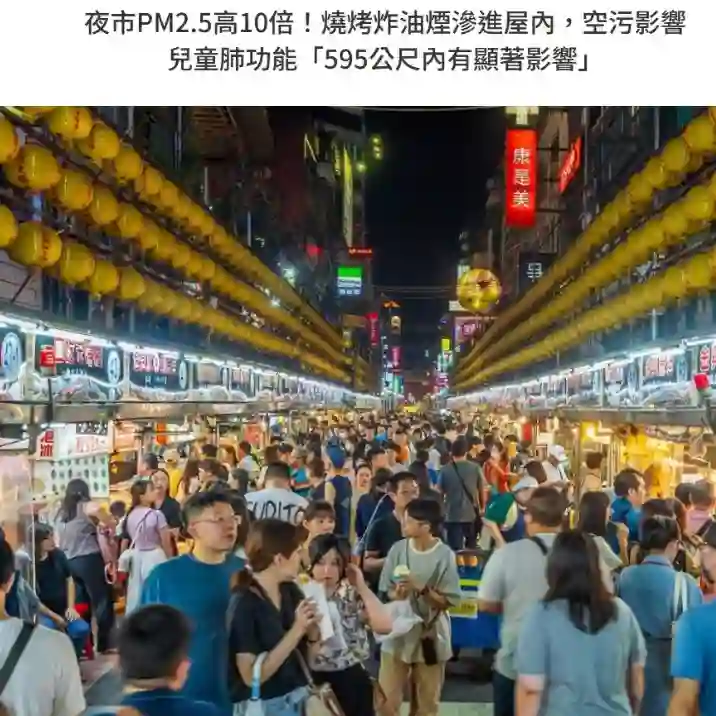PM2.5 Levels at Taiwan’s Night Markets Are 10 Times Higher

Night markets are a beloved part of Taiwan’s cultural identity and a major draw for tourists, but the smoke from open-air food stalls may be creating more than just mouthwatering aromas. A recent cross-institutional study led by researchers at National Sun Yat-sen University has revealed that air pollution generated during night market hours doesn't just stay outside—it can penetrate nearby homes and potentially harm children’s lung function.
While night markets offer iconic street foods like fried chicken cutlets, stinky tofu, charcoal-grilled skewers, and oyster omelets, residents living nearby often complain about strong cooking fumes. Visitors strolling through the markets may also be unknowingly exposed to dangerously high levels of PM2.5, a fine particulate pollutant that can seriously affect respiratory health.
This collaborative study, led by Professor Lin Yuan-Tsong of the Institute of Environmental Engineering at National Sun Yat-sen University, and Professor Chen Pei-Shih of the Department of Public Health at Kaohsiung Medical University, found that children living near night markets may face increased health risks due to elevated air pollution levels.
PM2.5 Levels Spike on Market Days
The team studied 58 households near night markets in Kaohsiung. Using questionnaires, real-time air quality monitoring, and lung function testing on children, they discovered that indoor PM1 and PM2.5 levels were significantly higher on market days compared to non-operating days, clearly indicating that cooking and burning activities at night markets contribute directly to local air pollution.
Further analysis showed that households located within 595 meters of a night market ("near group") had higher indoor concentrations of CO₂, CO, SO₂, total volatile organic compounds (TVOCs), and PM10 compared to those living farther away ("far group").
Night Market Pollution Is Affecting Children’s Lung Development
Even after adjusting for confounding factors like incense burning, indoor cooking, and smoking, the study found that children in the “near group” had noticeably lower lung function metrics, such as total lung capacity and forced expiratory volume in one second (FEV1). This suggests that pollutants from the night market are entering indoor environments and may be negatively impacting children's respiratory development.
The research team warns that long-term exposure to fine particulate matter and harmful gases can raise the risk of respiratory illnesses in children and hinder healthy lung growth.
Short-Term Exposure to PM2.5 Can Be Dangerous
PM2.5 particles are small enough to bypass the nose and throat, penetrate deep into the lungs, and even enter the bloodstream. This can cause or worsen conditions such as asthma, bronchitis, pneumonia, and chronic obstructive pulmonary disease (COPD). Brief exposure to high concentrations can also increase the risk of heart attacks, arrhythmia, high blood pressure, and may trigger sudden cardiac arrest or stroke.
Carcinogens in Night Market Smoke Linked to Lung and Heart Diseases
Previous research by Academia Sinica showed that PM2.5 levels at night markets and restaurants ranged from 70 to 200 micrograms per cubic meter—and sometimes spiked to 500, which is 5 to 10 times higher than typical urban outdoor levels. Dr. Lung Shih-Chun, a researcher at Academia Sinica's Research Center for Environmental Changes, noted that barbecuing and deep frying at night markets also release carcinogenic chemicals, which may increase the risk of lung cancer and cardiovascular disease.
How Nearby Residents Can Protect Themselves
Experts recommend several steps to reduce exposure for those living near night markets:
- Keep windows closed during market hours
- Install airtight windows, especially in lower-floor apartments
- Use air purifiers with strong filtration capabilities
- Limit children’s outdoor activities during market operating hours
- Grow balcony plants that can help absorb PM2.5 and other pollutants
These measures can help reduce the health risks posed by night market air pollution, especially for vulnerable groups like children.
News Resource: PM2.5 Levels at Taiwan’s Night Markets Are 10 Times Higher
How Night Market Air Pollution Affects You—And What You Can Do About It
Q1: Did you know that just a weekend stroll through a night market could expose you to dangerous levels of PM2.5?
A1: During peak hours, PM2.5 concentrations at night markets can be several times higher than indoor or outdoor air safety standards. Even short-term exposure can affect sensitive groups such as children, the elderly, and people with asthma. High protection masks (such as EN 149 masks) can offer effective protection in these high-pollution environments.
Q2: How does an EN 149-certified mask help in such environments?
A2: EN 149 masks, such as our smoke protection mask, are designed to filter out at least 95% (FFP2) of airborne particles, including PM2.5, smoke, dust, and oil-based aerosols. They provide reliable protection in high-exposure areas like night markets, while maintaining breathability for long-term wear.
Q3: Does your home sit within 500 meters of a night market? How can you improve your indoor air quality?
A3: Try using the Dacian PM2.5 Window Screen Filter along with an air purifier for better protection. This reusable mesh filter attaches directly to your window screen, blocking dust, pollen, and PM2.5 particles from entering your home while still allowing airflow. It's washable, easy to install, and ideal for homes near high-pollution areas like night markets.